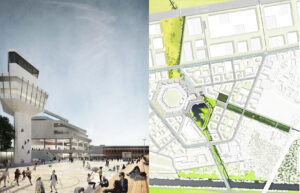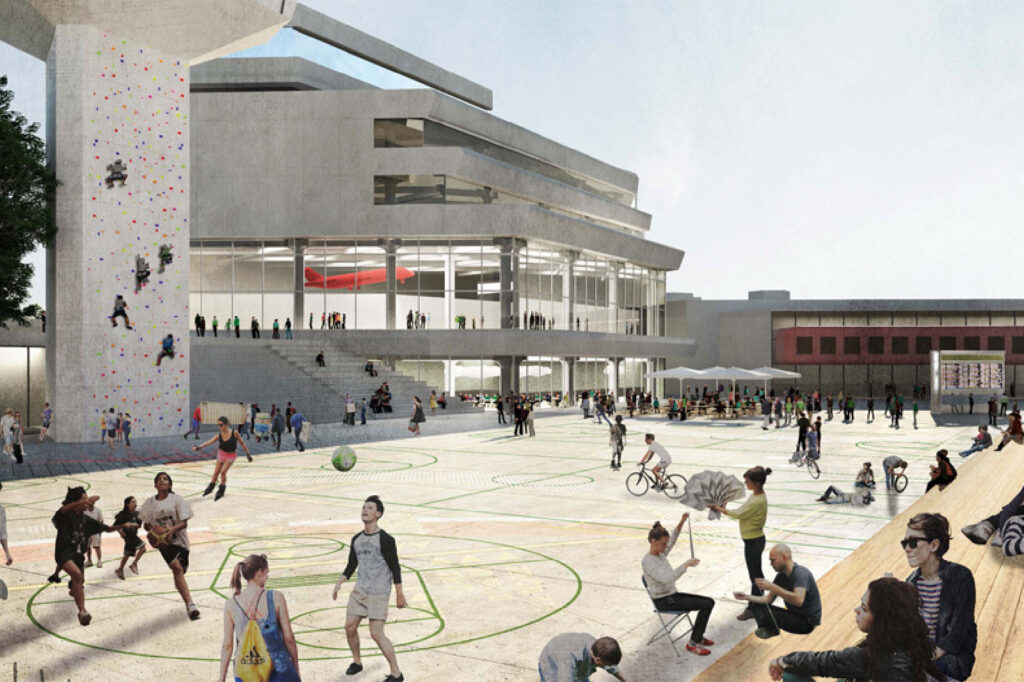A climbing wall on the tower, green corridors stretching in three directions, and wetlands for purifying rainwater. This is how Tegel Airport might look just a few years after it ceases operations. At least according to plans developed by Atelier Loidl, which submitted the winning design for the Campus Berlin TXL competition.
The campus will be the public space at Berlin TXL – the Urban Tech Republic. The old terminal will soon be surrounded by a vast amount of open space with a number of different uses in order to make the location more attractive.
Green branches connect the Urban Tech Republic with surrounding landscape
The center was and will remain the former airport terminal, which will house Beuth University of Applied Sciences. Green corridors will stretch out from the former terminal in various directions, culminating in a number of different landscaped areas. In the southeast, a wooded area will rise up around the fairgrounds, and in the north, a strip of green will connect the main building with the former airfield. The lake that is to be created in the middle of the loop – which currently serves as the driveway to the terminal – is particularly striking. A promenade with dining options and seating areas forms a sharp contrast with the natural marshy landscape and deep coves on the opposite shore, which offer seclusion and privacy. The lake will be used to purify rainwater and may play a significant role for the area’s microclimate thanks to its cooling and evaporation effects. Finally, there will be green connections to Jungfernheide and the ship canal stretching south from the lake. These greenways will connect the area with the surrounding landscape and offer open access to all sides.

The campus will be the Urban Tech Republic’s hot spot
Finally, there will be green connections to Jungfernheide and the ship canal stretching south from the lake. These greenways will connect the area with the surrounding landscape and offer open access to all sides.
The campus will be the center of the Urban Tech Republic. Its open and flexible design includes playing fields, large wooden bleachers, dining options and lots of space for creating a lively and interactive site. “Urban casual” is how Felix Schwarz of Loidl describes the atmosphere that he envisions for the space. Loidl swayed the jury with its idea of retaining the airport’s visual elements. Its lamps, painted areas, and markings will remain in place and be integrated into the design. “Rather than denying history, this concept respects it and develops it further,” said Professor Engelbert Lütke Daldrup, the Permanent Secretary for Building and Housing, of the decision. However, Dr. Philipp Bouteiller, CEO of Tegel Projekt GmbH, emphasizes that the draft is not the final design. “The aim of the competition was to find a strong partner for planning. Atelier Loidl showed that they understood our desire to create an open and livable space here.” The plans will now be developed further over the next several years so construction can begin right after the airport ceases operations in 2018. It is estimated that this will take five to seven years. Bouteiller is aware of the challenges that Berlin is facing already today. In view of the increasing number of people moving to the city, the closure of the airport is an enormous stroke of luck for Berlin. Other cities would like to be able to close urban airports as well in order to use the space for different purposes, such as much-needed housing. “When we talk about modern urban planning, we also try to integrate housing and work. That is what we are doing here,” says Bouteiller.
The four designs can be viewed at the Neues Stadthaus through February 4:
Monday through Friday from 2 p.m. to 7 p.m.
Saturday through Sunday from 10 a.m. to 4 p.m.
Neues Stadthaus, Otto-Suhr-Saal, Parochialstr. 1-3, Eingang 3, 10179 Berlin
Press information (in German only):
Berliner Morgenpost: So könnte es künftig am Flughafen Tegel aussehen
Berliner Zeitung: Tegel-Tower wird zum Kletterturm, Parkplätze zur Seenlandschaft
Tagesspiegel: So sieht die Zukunft am Flughafen Tegel aus
